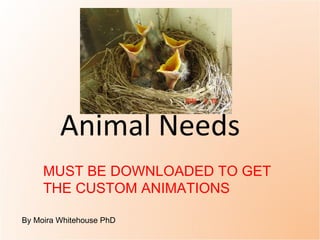
Animal needs. (teach) pptx
- 1. Animal Needs By Moira Whitehouse PhD MUST BE DOWNLOADED TO GET THE CUSTOM ANIMATIONS
- 3. A lizard needs a rock to hide under to protect it from hungry birds. A bear needs to roam a large area to find enough food.
- 4. And where do animals get these resources to satisfy their needs? habitat . They get these resources from their
- 5. And what is a habitat? A habitat is the environment in which an animal lives and satisfies it needs. This lizard lives in part of a desert—this is its habitat.
- 6. An animal’s habitat is made up of living and nonliving things. Identify some living and non living things shown in this bit of habitat.
- 7. An animal uses other living things in its habitat to satisfy some of its needs A giraffe eats the leaves of an acacia tree.
- 8. A lion hunts other animals for its food.
- 10. List some ways that animals use energy. Animals need energy. Energy allows animals to do things.
- 11. A monkey uses energy to swing through the trees. A fish uses energy to swim through the water.
- 12. A snail --to make slime so it can slide easily over a tree branch. A bison mother-- to make milk for its calf.
- 13. Animals use the energy to grow, to move around, to protect themselves and many other things. Without a source of energy an animal will die. And where does an animal get the energy to move, grow and reproduce?
- 16. This is called a food chain.
- 17. As you can see, one of an animal’s most basic needs is the need for food. But what some other things do animals need to survive?
- 19. Water helps transport food and other substances in an animal’s body. It also helps remove waste products. Water is used to cool an animal down, to warm it up, and to carry out the processes that allow it to move and grow.
- 20. The Need for Oxygen Animals get oxygen in several different ways. Almost all animals need oxygen in order to get energy from their food. So what else besides food and water do animals need to survive?
- 21. Most land animals breathe in oxygen directly from the air while many animals that live in water take in oxygen that is dissolved in the water.
- 22. The Need for Shelter Animals also need some type of shelter—a place where they and their young can be safe from bad weather and from their predators (animals that hunt them).
- 25. For fawns, shelter might be a soft place in the woods.
- 26. Bears find shelter in dens.
- 27. The Need for Protection In addition to a shelter, animals need other ways to protect themselves and their young. They have defenses to protect themselves from animals that hunt or attack.
- 28. Some animals use camouflage—they look like their surroundings.
- 29. Other animals have sharp teeth, horns or hooves for defence.
- 30. Others live in large groups such as herds.
- 31. Some animals hide to make it hard for their their enemies to see them. The fish hides in the sea weeds so it won ’t be eaten.
- 32. The Need to Keep Warm or Cool Animals need to keep their bodies at a certain temperature. If an animal’s body becomes too hot or too cold, it will die.
- 33. Cold blooded animals such as snakes lie in the sun during the daytime to warm up. At night they often move into underground burrows to stay warm.
- 34. Warm blooded animals such as mammals and birds often have a layer of fur, fat or feathers to keep their body heat from escaping in the cold weather.
- 35. The Need for Space All of an animal ’s needs must satisfied within the area or space in which it lives. Except for oxygen, the resources that an animal needs are usually limited. If too many living things are packed in a small living space, it is likely that some of these creatures will not be able to satisfy their needs and die .
- 36. So animals need enough room or space to satisfy their need for food, shelter and water. Only a certain amount of food and shelter can be found. During certain times of the year, there may not be enough water for all to drink.
- 37. Some animals like coyotes, foxes and wolves mark the their territory by urinating along its boundary, something like a “keep out” sign that tells other coyotes, foxes and wolves to stay out of their space.
- 38. A grizzly bear male needs between 200 to 500 square miles of habitat to satisfy its needs for food, shelter and water..
- 39. The city of Fort Worth takes up about 300 square miles of space.
- 40. Although several bears live in one area, one male grizzly would need an area about the size of Fort Worth or larger to satisfy its needs. But where would we live?
- 41. On the other hand, an earthworm only needs a very small area in which to live—maybe a few square centimeters.
- 42. The area in which an animal lives and satisfies its needs has a name. Can you remember that name? Yes, it is called its habitat.
- 43. Habitats
- 44. In this lesson we have learned that in order to survive and do well, animals have certain basic needs. Can you remember what they are? Think hard.
